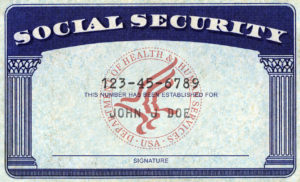Today we will look at a few of the ways social security benefits and bankruptcy overlap. A number of recent studies have found that older people are making up an increasing amount of bankruptcy filers. Many elderly people either receive social security benefits already, have social security benefits pending, or will become eligible for social security benefits in the near future. The result is an increasing overlap between social security benefits, creditors and bankruptcy.

Different ways Social Security Income impacts Bankruptcy
Social Security Income (SSI) needs to be considered in a number of different areas on the bankruptcy petition. It will impact Schedule B/C, Schedule F, Schedule I/J, and the means test and it will impact each of these areas very differently.
Schedule B and Schedule C
Schedule B is the area of the bankruptcy petition where your personal property assets need to be listed. Schedule C is the area of the bankruptcy petition where you are able to exempt personal property from the reach of creditors or the trustee.
A bank account that only consists of social security income should be listed on schedule B and exempted on schedule C. If the social security income was never co-mingled with any other funds then they will be completely exempt in bankruptcy. Additionally, outside of bankruptcy, if the social security income has never been co-mingled with any other funds then creditors are prohibited from garnishing that account as your social security income is exempt from garnishment. Although creditors can use other means of collection such as liens and seizures, this makes it much for difficult for them to collect on a judgment.
If you are owed social security back pay, this will also need to be listed on schedule B and exempted on schedule C. Even if you have never received the back pay, but there has been a determination made that funds are owed to you, then it must be listed on schedule B. Social Security back pay are completely exempt from the reach of creditors, but it is important to still list and exempt the asset.
Schedule I and Schedule J
Social security income also needs be considered when filling out schedule I and J. Schedule I lists household monthly income. This includes employment income, pension income, retirement income, and social security income. This is important is because the Bankruptcy Court considers your ability to repay your creditors based on your current monthly income (schedule I) and currently monthly expenses (schedule J). After deducting your monthly expenses from your monthly income, there is too much money leftover, the court may require you to use a portion of that money to fund a chapter 13 plan.
Means Test
The Means Test is another area of the bankruptcy petition where social security income plays a role. The means test is used to determine whether or not there is a presumption of abuse of the bankruptcy process. It is based on your household income over the last six months in relation to your household size. However, social security income is excluded from the means test.
This means there may not be a presumption of abuse of the bankruptcy process based on the means test, but schedule I and J show there is enough income leftover every month to pay back your creditors. This creates quite a predicament and should be analyzed by an experienced bankruptcy attorney.
Overpayment of Social Security Benefits
Social security overpayment is considered an unsecured, non-priority debt. This is similar to credit cards and medicals bills and should be listed on Schedule F of the bankruptcy petition.
Upon filing of a bankruptcy case, the collection activity must stop immediately against those owing overpayment of social security benefits. The automatic stay also prevents the collection action against a co-debtor. Therefore, even if a child or spouse has a debt listed in the petition the recovery against the child or spouse’s debt must stop also.
If an amount is received by the social security administration after the case is filed (which is not uncommon) it must be refunded to the client.
As with all debts, if the social security administration thinks the debts were obtain through fraud or false pretenses then the social security administration has the option to file an adversary proceeding to exclude the debt from being discharged in the bankruptcy.
As you can see, there are a number of different ways social security and bankruptcy overlap. Please contact an attorney at our office if you have any questions.
